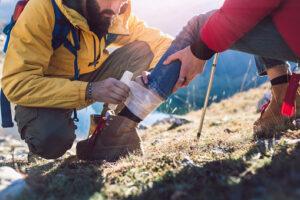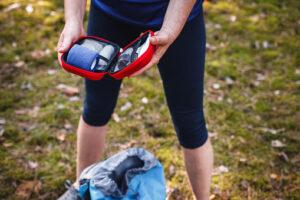Reasons to keep FIRST AID KIT on a trek
There is no thrilling adventure than Trekking!
You become one with nature following trails full of flowers, cascades, tall conifers, rocky paths, steep terrain and snow. Then there are new cultures and traditions that you get introduced through exchanges with the locals on high altitudes. The peaks also make you look inward for some peace and quiet.
In conclusion a summit finish is the self-gratifying reward!
The complete activity looks so glamorous and inviting! There is however a downside to this exciting activity. Trails are fraught with certain dangers and physical challenges that trekkers, guides or support staffs have to address during a trek. An ultra light backpacking first aid kit could prove beneficial and timely to tackle such situations.
Here are few situations that a trekker has to face…
1. Uneven terrain
- Slippery ground and uneven mountain terrain can cause cuts, sprains and fractures.
- You might think a minor cut is not an issue and can carry on. But, during the trek you have to keep moving through flowing waters, trees, rocks and mud that may aggravate the injury.
- Knee pain is common problem due to rocky and uneven terrain. Soreness, numbness etc. happens, hampering progress.
- Heels may get blisters from long hours of walking
2. Common ailments due to weather vagaries
- Intense sun, heavy snow or strong winds can cause damage your skin. Sun burns, wind burn, cold, frostbite are some common ailments experienced during treks.
- Weather vagaries also can also cause illness such as diarrhea, cough, influenza, pneumonia, Dengue, Zika, Chikungunya, and yellow fever.
- Germ causing microbes can cause malaria, worm infections – hookworm etc
- Parasites, tapeworms in contaminated food trouble your stomach while skin infections occur due to bacteria and fungus that you come in contact with on enroute to the destination
- Blood sucking ticks in wooded and grassy lands cause of irritation and are sometimes painful. They may cause swelling and/or diseases such as Lyme disease.
- Heavy snow or serious changes in weather cause some unique problems. You may be stranded high above with no communication access to the world.
3. Dehydration
Dehydration is a common problem faced by many trekkers up in the mountains.
4. Accidental injuries
Some injuries arise out of minor accidents like scalding. A pot of boiling water may trip over or you may drop tea on your skin.
5. Altitude sickness
There is a drop in atmospheric pressure at high altitudes. The oxygen supply also decreases drastically. People living at high altitudes are used to it. But people from plains trekking to probably above 8000 feet are vulnerable to altitude sickness
- Mildest form of altitude sickness is like a hangover – you may experience a headache, nausea or dizziness, mild muscle aches
- Severe altitude sickness may lead to build up of liquid in the lungs or brain and may prove fatal.
- Symptoms include headache, nausea, vomiting, loss of appetite are some signs to look out for
Trekkers suffering from such ailments are closely monitored. The ones with mild altitude sickness will feel better within 2 days. But they should travel higher terrains with caution.
Why First aid kit is important in hiking
All the above are situations that can halt further progress. Instant recovery and resumption of trek is very much necessary due to various reasons. However seeking immediate medical help is difficult due to the remoteness of the location.
For situations that are life-threatening there is no other option but to stop progress and seek immediate attention. However you can seek solutions for minor injuries in a hiking first aid kit.
Three Ps to highlight the need for first aid kit
- Preserve Life
- Prevent further harm
- Promote recovery
Trekking agencies, as a rule, are trained to handle such issues and support travelers accordingly. But carrying a small kit in our own bags can facilitate healing when there is a shortage of medicine or kits during emergencies.
There is another reason why a personal first aid kit becomes essential. Some people are allergic to certain medicines. A personal kit with personal medicines that they use regularly would be preferable at all times because of this very reason.
The best backpacking first aid kit could contain–
- Medicine
- Small tools
- Kits for minor cuts and burns
Elaborating further…
- Plaster, medical tape, some antiseptic or alcohol wipes, dressing gauze can solve the issue of minor cuts. Knee supports in first aid kit may perhaps treat knee pain and niggles. Spray or gel is the remedy for muscle catches. Blister dressing kit can ease pain and also cause speedy recovery.
- Hand sanitizers and masks can protect you from contagious diseases. Likewise you can carry some OTC tablets or tablets prescribed by your doctor.C) Ibuprofen (10-200 mg) – pain relief, anti inflammatory,
- Antihistamine tablets – for allergic reactions or bites
- Acetaminophen for headaches
- As per requirement the first aid box can contain antibiotics, rehydration solution, diarrhea stoppers
- Insect repellants could solve the issue of pesky insects
- Inhalers for nose blocks
- Digene or gelusil for issues of digestion.
- Diamox can be taken for relieving symptoms of altitude sickness, but on advice of your doctor.
Victims can take the medicine to ease their illness, although they should wait for their body to acclimatize to move further up. Trekkers suffering from severe altitude sickness should better seek medical attention at the earliest.
10. In case you lose your way due to a snow storm or landslide and await help, you can keep warm with foil blankets. Foil blankets reflect over 90% of radiated body heat keeping you warm. An emergency whistle can reach trekkers nearby or help rescuers locate you.
11. For scald injuries burn stop sachet has a gel that cools burns. Sun screen could protect you from harsh sun rays during your trek.
12. Some of these tools prove helpful.
13. Ticks remover can remove nasty ticks that suck blood and cause harm
14. Utility tool such as Swiss knives come in handy on any type of travel.
15. Disposable gloves could prevent infection
16. Thermometer
17. Safety pins to fasten bandages
18. Now that your kit is ready, go forth and enjoy the ascent and wilderness.
Now that the first aid kit is ready, you can go all out and enjoy the adventure of your lifetime sans worries.
Blog by KALPANA CK
Quick Links
Information
Contact Info
- Bhuntar, Kullu
- Dwarka, New Delhi
- +91 9971355865
- info@kashtiadventures.com
In a Nut shell
Certified by MSME, Govt. of India, we are a 5 star rating company making golden efforts to beautify travellers experience.
Kashti Adventures. Developed By Digital webster
Copyright © 2021. All rights reserved.
Book my trip


